Installing a solid fuel boiler: do-it-yourself nuances of installing a boiler
Solid fuel boilers are used to heat private buildings that are not connected to centralized gas pipelines. Illiterate installation of units that process solid fuels can be a serious danger to home owners. Strict adherence to installation rules will eliminate the threat. Do you agree?
We will tell you how to install a solid fuel boiler in strict accordance with regulatory requirements. The article carefully describes the preparatory and installation stages, provides the rules for arranging mini boiler houses. Based on our tips, connecting the unit to heating will not cause difficulties.
The content of the article:
- Choosing a room for the unit
- Ventilation device in a room with a boiler
- Chimney installation work
- Preparing the boiler room for installation of the unit
- Basic steps for installing the boiler
- Connecting the unit to the heating system
- Recommendations for efficient operation
- Conclusions and useful video on the topic
Choosing a room for the unit
We will examine as much as possible in detail what is a solid fuel boiler? This is a thermal device equipped with an open combustion chamber.
The scheme of its connection to the heating system of a private house can be based on the technical requirements for open or closed heating systems. Everything will depend on the operating conditions.
Requirements for open systems are:
- connecting a system for removing solid fuel combustion products to a chimney, in which the draft will be carried out naturally;
- installation of an expansion tank at the highest point of the heating circuit through which the connection of the heat carrier with the atmosphere will be established;
- Constantly providing the heating system with the water needed to maintain it in working condition.
Although owners of private homes are more likely to install closed heating systems, rather than open.
All solid fuel boilers have quite impressive dimensions. And therefore, they are made exclusively in a design that provides for floor placement.
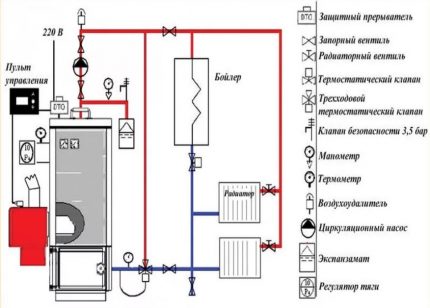
The installation of a solid fuel boiler provides for a considerable scope of work:
- determination of the premises for placing a solid fuel heat generator;
- preparatory work in the boiler room;
- installation of ventilation system of supply and exhaust type;
- installation of the boiler and flue system;
- boiler piping;
- test run of the heating system.
Only by observing such an algorithm of actions can problems be avoided during the installation of a solid fuel unit, as well as during its further operation.
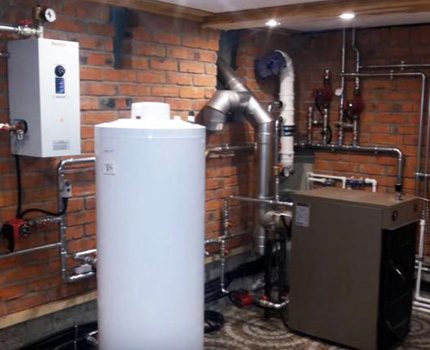
Items 1-3 of the above work order are preparatory work. But this does not mean that their implementation should be approached less scrupulously than directly to the installation work.
In the case of the wrong choice of premises for the installation of the heating unit and errors during the installation of the ventilation system, problems with the operation of the heating system of a private house will not be long in coming. And you will have to look for a solution in the midst of the heating season, in the cold season.
Therefore, it is better to immediately correctly install both the heating equipment in a private house, and the solid fuel boiler itself. To do this, it is necessary to develop a detailed installation plan in advance, given that the installation of some types of solid fuel boilers may include power from the mains.
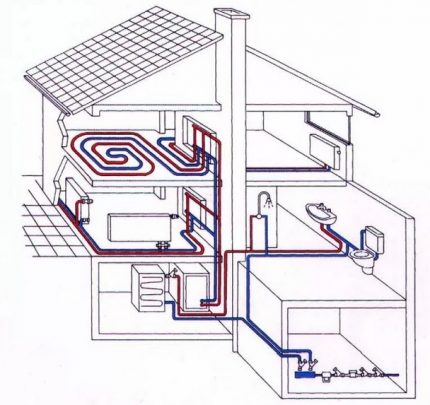
In the installation issue, one has to focus on the basic norms of SNiP “Heating and ventilation” and some provisions of SNiP 31-02-2001 “Single-family houses” (for the Russian Federation).
The burning of solid fuels leads to an increase in the dust level of the room, and during the burning of firewood or coal a different amount of smoke can leak into the room.
Therefore, installing a boiler in the immediate vicinity of residential premises is undesirable. Although, according to regulatory documents, the installation of a solid fuel boiler is allowed in the premises of the kitchen, corridor and other non-residential rooms.
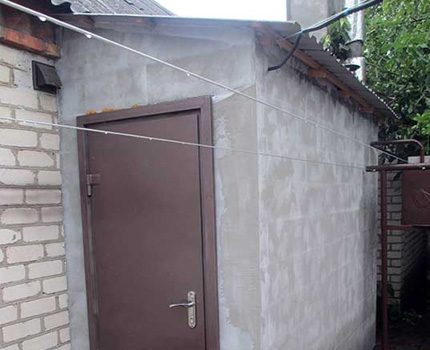
The optimal places for installing the boiler is separate specialized roompreferably separated from the house. As an option, a technical room attached to the house and properly equipped is suitable.
Also a good option would be to place the thermal unit in the basement or in the garage. You can install it in the corridor, but subject to the availability of sufficient space and good ventilation of the room.
Ventilation device in a room with a boiler
When there is little fresh air, the process of burning fuel will be difficult. If it enters in excess, the process of burning solid fuel becomes difficult to control.
If the intake of fresh air is difficult, it is necessary to build a ventilation system.
Ventilation is necessary in order to:
- ensure the supply of fresh air at the level necessary to maintain the combustion process in the boiler furnace;
- to bring out from the premises solid fuel combustion products that accidentally exit from the furnace to the boiler room;
- ensure the process of receiving an adequate volume of fresh air.
Such simple measures will help to safely and efficiently operate a solid fuel boiler for a long time.
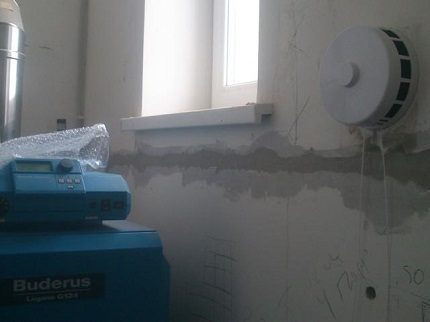
As for directly arranging the ventilation system for the boiler room, the following tips are designed to help build it correctly.Firstly, the exhaust and inflow openings should be located at different ends of the boiler room.
It is advisable to place the exhaust hole closer to the roof, and the supply duct should be located in the lower part of the room, in close proximity to the solid fuel boiler itself.
Secondly, it is impractical to install an exhaust device near the heat generator, the design of which provides a fan (supercharger) or smoke exhaust.
In this case, during the operation of the turbine, the draft in the duct will forcefully change the direction of the air flow, and the air that must go into the hood will be again supplied by the inflow into the boiler room.
If the entrance to the boiler room is equipped directly through the door from the living room, it will be advisable to install a supply grille in the lower part of the door. The influx of warm air from the living room will increase the heat output from the burned solid fuel.
Given that most of the supply air is directly in the combustion chamber of the boiler, where it reacts with the carbon released as a result of the combustion of solid fuel, and then comes out in the form of carbon dioxide, the exhaust opening should have a smaller diameter than the intake opening.
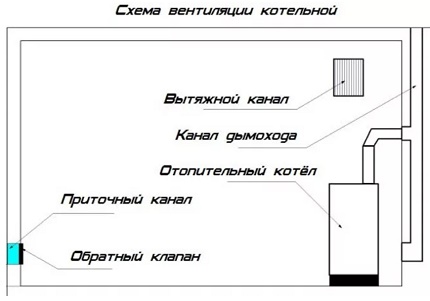
The best option is to install the boiler closer to the external walls. This will avoid the hassle of laying a long horizontal chimney channel, especially in cases where it will be removed through the roof.
Common boiler house layout schemes and engineering design rules given here.
Chimney installation work
The procedure for installing the boiler on a special foundation or on the floor is extremely simple. It consists in simply exposing the thermal unit in a position in which it will continue to operate. Next, its location must be aligned by adjusting the legs, or special metal pads.
But it is not necessary to monitor compliance with the coincidence of the axes of the chimney branch pipe and the corresponding hole in the wall during installation. Here, alignment can easily be adjusted by adjusting the knees.
In order to avoid possible problems associated with the appearance of condensate during the operation of the boiler, it is advisable to build a chimney of a solid fuel boiler from insulated sandwich pipes, or, as an economical option, assemble the structure with your own hands from pipes wrapped with basalt fibers.

Installation of this type of chimney is carried out as follows: the pipe is attached to the wall in an upright position, and already a flue from a solid fuel boiler is connected to it through a tee.
As for the installation of the chimney in wooden houses, the hole in the outer wall or roof is made in strict accordance with the rules of fire safety.
First, an equilateral opening is cut out in the partition, and the dimensions of its sides must exceed the dimensions of the internal chimney pipe by 380 mm. from each side. For example, we have a channel with a diameter of 100 mm and a sandwich pipe, the insulation thickness of which is 500 mm. In this case, the opening size will be: 100 + 380 x 2 = 860 mm.
Next, the installation of the passage unit is made in the form of a duct made of steel with zinc coating. A sandwich pipe is pulled through this box, and the voids surrounding it are filled with basalt wool. The final operation will be fixing the lid of the assembly located outside.
When performing installation work, it is worth remembering that it is easiest to lay a chimney channel in a brick wall or a foam block wall, using a seal and a steel sleeve.
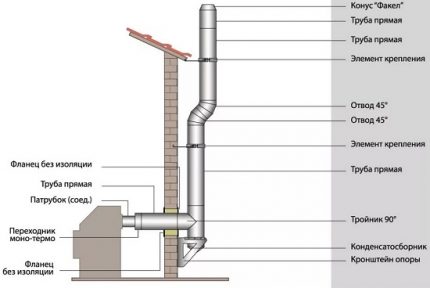
However, during the installation of the chimney duct, the following requirements must be observed:
- the pipe should be turned no more than three times, while its minimum height, counted from the grate of the solid fuel unit, should be at least five meters;
- sections of the chimney should be connected so that rainwater flows down the outer wall, and condensate moisture - on the inside;
- the horizontal part of the pipe should be installed at a slope towards the boiler.
In the lower part of the chimney, it is necessary to install an inspection hatch and a reservoir to collect accumulated condensate moisture. And in order to avoid the intersection of the chimney with the eaves, the latter can be circled by using two adapters at 30 degrees.

During the installation of the chimney, it is necessary to ensure that the joints of the chimney sections do not coincide with the placement of the pipe fasteners to the wall. To the top chimney pipe it is advisable to place a protective cap or a rotating weather vane.
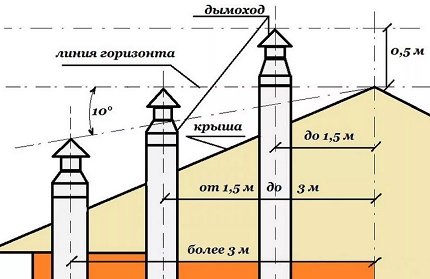
When working on the creation of a smoke ventilation system, it is worth remembering that the head of the chimney pipe should not be located in the zone of wind support of any of the houses (both its own and neighboring ones). And in order for the draft to always be stably good, the chimney pipe must be installed at the level shown in the above diagram.
For the convenience of servicing and cleaning the heat exchanger of the solid fuel unit from all sides, from where these actions are planned, it is necessary to create the possibility of access to the boiler. An ideal option would be to create a meter gap in front and on the side of the side and rear walls of 60 cm. Minimum these indents should be 25 cm.
Setting solid fuel boiler, it should be remembered that it is strictly forbidden to connect the duct of the thermal unit with the brick wells of the ventilation ducts of the house passing in the inner space of the walls.
On the eve of the acquisition and installation of a solid fuel boiler, it is necessary to carefully compare its height with the height of the future boiler. It is also worth pre-calculating the placement of other equipment of large sizes, such as a heat accumulator, a buffer tank and an indirect heating boiler.
Preparing the boiler room for installation of the unit
Solid fuel boilers with an open combustion chamber must be placed in separate special rooms - boiler rooms. Such rooms are equipped in the basement or in the basement, equipping them with an intensive ventilation system to ensure the normal operation of the solid fuel unit.
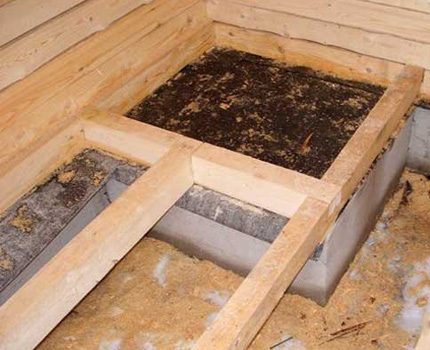
Solid fuel boilers can be installed on their own, without any coordination with the relevant services. However, in the process of installing a solid fuel boiler, a set of rules must be observed.
So, the floor at the installation site of the solid fuel boiler should be made perfectly smooth and durable. In most cases, boilers are installed on special stoves made of non-combustible materials.
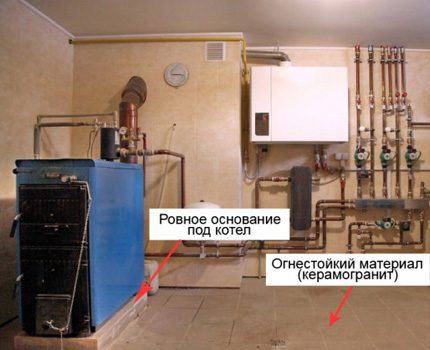
Install the boiler at a certain distance from the walls. The gap between the rear wall of the boiler and the wall of the room must be at least 60 cm, while the distance between the wall of the boiler and the front surface of the boiler must be at least 25 cm.
Before installing the heating unit, the walls and floor of the boiler room must be covered with fireproof material with a minimum fire resistance limit of 0.75 hours. For these purposes, sheets of metal, basalt cardboard, minerite or asbestos cement can be used.
Also, the boiler room should be equipped with a low ventilation system. It can be an ordinary window, or a hole made in the wall. At the same time, its area is calculated based on the capacity of the boiler: per 1 kilowatt of boiler power, there must be 8 square centimeters of the ventilation opening.
In the case where the boiler room is equipped with only lighting, it is worthwhile to install sockets with power supply from 220 V in it.

It is worthwhile to use a heat-resistant sheet to close the floor directly at the installation site of the boiler so that the protective material protrudes forward 80 cm from the front wall of the boiler. This measure will help to avoid the occurrence of fire in the event of heat falling out of the furnace.
All manufacturers of thermal units in the installation instructions for their products recommend building a foundation for installing a boiler on it. So, if the boiler is of low power, the weight of which does not exceed 200 kg, it can be installed with a calm soul on the basis of a cement screed. In the case of a proper arrangement, it can withstand this kind of load without problems.
But for the installation of the unit, the weight of which exceeds 300 kg, it is advisable to build a base of reinforced reinforced concrete screed. Moreover, its thickness should be from 10 to 12 cm. If the weight of the boiler exceeds 300 kg, then it must be installed exclusively on a base consisting of a separate foundation plate.

Solid fuel boilers are allowed to be installed on a wooden floor. However, to begin with, the installation site will have to be prepared with your own hands, having previously been strengthened with beam-shaped lags, the cross section of which is at least 100x50 mm.
If the installation of additional heavy equipment is planned in the boiler room, then it is impractical to fill the foundation for each unit. In this case, it is much easier to fill the so-called industrial floors, that is, make a screed of concrete to a height of 12 cm.
At the same time, reinforcement with a diameter of 8 to 14 mm should be its filling. Then you need to make a dense pillow of rubble, and put a grid with a window size of 20x20 cm on top.
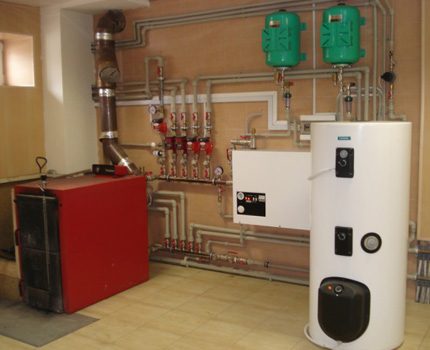
Based on how the boiler is connected to the chimney: through the roof or through the wall, it is necessary to design the placement of the hole through which the chimney pipe will be discharged and make it. At the same time, its inner diameter should coincide with the diameter of the outlet neck of the solid fuel unit or be slightly larger.
Basic steps for installing the boiler
In order to install a heating system based on the use of a solid fuel boiler, you need a heat unit itself, pipes and heating radiators, expansion tank, circulation pump, heat accumulator, components of the automatic control system of the boiler.
The latter include:
- safety valve;
- air valve;
- pressure gauge;
- Temperature regulator.
All manipulations related to the installation of a solid fuel boiler and the connection of peripheral systems and devices are carried out in accordance with a strict step-by-step algorithm. So, on the eve of the installation of the boiler at the place of its planned location, a specialized foundation is being erected.
At the same time, it is imperative to maintain all the necessary sizes of the indents and correctly position the body of the thermal unit both vertically and horizontally.
Next, electric heating elements are installed in the event that they are included in the package of the boiler. As a rule, solid fuel boilers are equipped with fasteners for the installation of heating elements, next to which a temperature controller is installed.
The next step involves installation and connection heating system pipes. It is important to close all connections with intermediate shut-off taps, and seal the butt joints with plumbing tape or with material consisting of flax fibers. This will simplify access for future repairs.
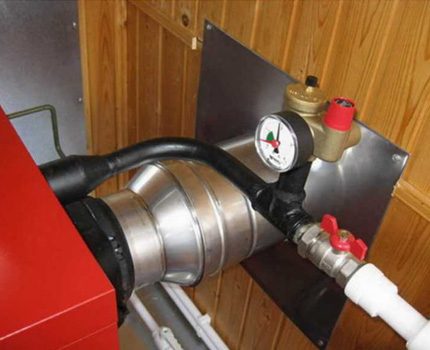
In the case when the operation of the heating system provides for the use of connections to the power supply of the house, at this stage it is necessary to make all the necessary connections for the wires, their insulation and grounding.
Next is the installation security groups. Its equipment depends on the model of a solid fuel boiler, but, as a rule, it consists of: a safety valve, an air valve, a temperature controller, a draft sensor, a pressure gauge and other devices. All these devices are installed up to all locking devices.
The next step will be the installation of the chimney pipe. At the junctions of the elements of the smoke exhaust system, they are sealed with a sealing substance that is resistant to high temperatures.
The installation procedure, the height of the chimney duct, as well as the cross-sectional area are calculated so as to further ensure the natural draft process at the proper level. And for this, it is necessary to strictly observe all the requirements of the operating instructions for the installed boiler model.
Next, the thermal circuit of the solid fuel boiler is filled with water. At first, the water pressure level should be slightly higher than the working one. This step involves testing the system for leaks.
Then it is necessary to check all the internal elements of the furnace of a solid fuel boiler: plugs for cleaning, kindling flaps, fireclay stones, grates, etc.
And finally, it is necessary to discharge the pressure in the boiler to the operating parameters, put the shutters in the furnace and in the chimney in the position prescribed by the instructions, and put solid fuel in the boiler.

To start the heating process, it is enough to load fuel into the boiler and set it on fire. Further, after 10-15 minutes, it is necessary to tightly close the shutter for kindling.
After the temperature is set at 80-85 degrees, you will need to set the temperature control to the desired heat supply mode. Subsequently, it will simply be necessary to supply the boiler with solid fuel if necessary.
Connecting the unit to the heating system
After completion of the installation of the solid fuel boiler and smoke extraction system, the next stage of work will be the so-called piping. When implementing it, one rule must be strictly observed: during operation of the heating unit, under no circumstances should cold water get into it. Especially the one in which the heat exchanger is made of cast iron.
If this happened, then the boiler walls are immediately covered with condensation moisture.The reason for this will be a sharp temperature drop. This liquid is dangerous in that when it comes into contact with soot deposited on the sides of the boiler, it turns into a viscous and dense layer of plaque.
Sticky coating is quite difficult to remove from the surface of the walls of the boiler, in addition, it significantly reduces the efficiency of the thermal unit. To minimize the process of condensate evolution, when burning solid fuel in the boiler, you can perform a typical piping scheme with a three-way valve and bypass when setting the coolant to a stable temperature of 50-55 degrees.
Thus, the water in the system will move in a circle until it reaches the above temperature. And after that, the valve will let cold water into the system.
In the process of strapping a solid fuel unit, it is important to consider the features of a particular model, having studied the manufacturer's instructions. So, it is important to carefully connect the control unit and burner. Sometimes in boilers of European brands an automatic fire system is installed, connected to the central water supply.
In order not to be mistaken in the process installation of the boiler on pellets It is necessary to obtain technical advice from official representatives of the boiler manufacturer. It is important to install all the components of the solid fuel system as prescribed by the relevant instructions.
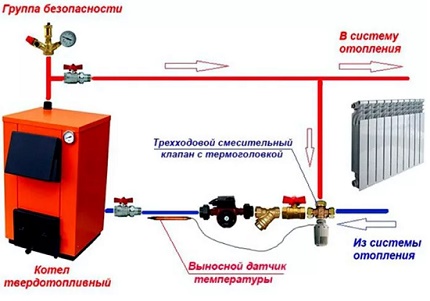
Recommendations for efficient operation
During operation of a boiler that consumes solid fuels, slag deposits remain in its furnace. As they accumulate, they must be periodically removed. In addition, to maintain the energy efficiency of such a boiler, certain actions should be taken periodically.
Firstly, from time to time, the walls of the boiler must be cleaned of accumulated ash and carbon deposits. Due to the millimeter layer of carbon deposits on the walls, the energy efficiency of a solid fuel boiler is reduced by 3%. It must be cleaned at least once every seven days. In this case, the boiler must be turned off and its walls cooled down.
Secondly, as the grate of the grate is clogged with ash, the boiler will also gradually lose its energy capacity. If such a phenomenon has been noticed, it can be eliminated quite simply by slightly moving the contents of the furnace.
Modern models of solid fuel boilers are equipped with a special lever for turning coal, in addition, if necessary, it will help to dump coal.
Thirdly, in order to improve the circulation of water along the thermal circuit of the boiler, you can use circulation pump. This will significantly increase the energy efficiency of the thermal unit, since the movement of the heat carrier through the system will be much faster, and it will return to the boiler with a higher temperature.
This means that less heat will be consumed to reheat it, therefore, the energy efficiency of such a boiler will be noticeably greater.

Fourth, it is worth monitoring the status of the draft in the flue duct. And so that it is maintained in optimal condition, the chimney must be cleaned at least once a year. The sections of the chimney channel, which run through the rooms without heating, must be insulated.
This must be done to prevent the formation of condensation vapors. They, in turn, are harmful in that they accumulate and interfere with the normal release of combustion products.
And in order for the fuel to be used most efficiently, it is necessary to set the temperature regulator to the position of minimum performance, but only if the room at home is warmed up well and warmed on the street.

Conclusions and useful video on the topic
The nuances of heating a private house with a solid fuel unit are considered in the video:
Video about the installation features of one of the popular models of solid fuel boiler:
Installation work on installing a solid fuel heating boiler is not particularly complicated. There are no impracticable requirements for their implementation. And you do not need to get permissions from state authorities.
Although, from the point of view of practical implementation, this complex of work is very laborious and can be quite troublesome, since it consists of many nuances.
Please write comments in the block below. Ask questions on controversial issues, share your own opinion, useful information and photos on the topic of the article. Perhaps you want to talk about how the installation and connection of a solid fuel boiler was carried out in your country house or in the country?

 Solid fuel boilers: main types and criteria for choosing the best unit
Solid fuel boilers: main types and criteria for choosing the best unit 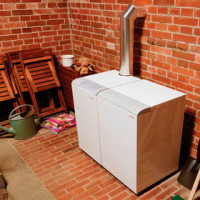 Do-it-yourself installation of a floor gas boiler: technical standards and work algorithm
Do-it-yourself installation of a floor gas boiler: technical standards and work algorithm 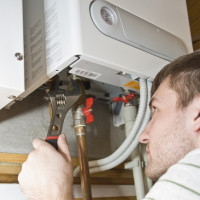 Wall-mounted gas boiler installation: do-it-yourself installation
Wall-mounted gas boiler installation: do-it-yourself installation 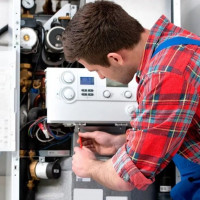 How to increase the efficiency of a gas boiler with your own hands: the best ways to increase the efficiency of the boiler
How to increase the efficiency of a gas boiler with your own hands: the best ways to increase the efficiency of the boiler 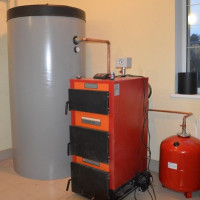 Do-it-yourself heating boiler piping: schemes for floor and wall boilers
Do-it-yourself heating boiler piping: schemes for floor and wall boilers 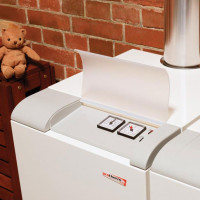 Installation of a gas boiler Protherm: features and main stages of installation + wiring diagrams
Installation of a gas boiler Protherm: features and main stages of installation + wiring diagrams  How much does it cost to connect gas to a private house: the price of organizing gas supply
How much does it cost to connect gas to a private house: the price of organizing gas supply  The best washing machines with dryer: model rating and customer tips
The best washing machines with dryer: model rating and customer tips  What is the color temperature of light and the nuances of choosing the temperature of the lamps to suit your needs
What is the color temperature of light and the nuances of choosing the temperature of the lamps to suit your needs  Replacement of a geyser in an apartment: replacement paperwork + basic norms and requirements
Replacement of a geyser in an apartment: replacement paperwork + basic norms and requirements